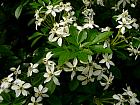Orange tree of Mexico, Choisya ternata 
shrub of the family Rutaceae as citrus fruit
 Etymology: the Orange tree of Mexico comes from Mexico and its flower resembles that of the orange tree. Its crumpled foliage reminds the smell of orange trees. Its name Choisya was given to it in honour of Jacques-Denis Choisy, Swiss botanist, philosophy professor and pastor of the Church of Geneva. Etymology: the Orange tree of Mexico comes from Mexico and its flower resembles that of the orange tree. Its crumpled foliage reminds the smell of orange trees. Its name Choisya was given to it in honour of Jacques-Denis Choisy, Swiss botanist, philosophy professor and pastor of the Church of Geneva.
The specific name ternata means "grouped by 3" by allusion to leaves composed of 3 leaflets.
Origin: Mexico, Central America, South West of the United States. The Orange tree of Mexico was introduced into Europe by 1825, by the surgeon, naturalist and botanist of La Rochelle Aimé Bonpland (1773-1858), who had discovered it in Mexico by 1804.
Habitat: the Orange tree of Mexico accepts an ordinary earth even a bit calcareous, well drained. It tolerates a sunny position, or half-shade. It appreciates hardly the cold winds.
Hardiness: zone 5 (it supports cold until - 29 °C or - 20 °F).
Growth: moderately slow.
Height: 2-3 m tall.
Shape: shrub, dense and rounded.
Persistent foliage, of light green colour at the beginning of foliation, then dark green. Leaves are opposed, composed of 3 lanceolate leaflets, sessiles, below glazed. They are aromatic.
 Flowers in May-June and September-October. We say that they are "remontant" (they reappear in late autumn). White, they are grouped in tight clusters of small flowers, 3 cm in diameter. They resemble that of the orange, hence the name of the shrub. Like those of the orange, they exude a sweet fragrance and are nectariferous which attracts bees and butterflies. They consist of five (sometimes six) petals apart, 8 to 15 stamens surrounding a golden yellow stigma green. Flowers in May-June and September-October. We say that they are "remontant" (they reappear in late autumn). White, they are grouped in tight clusters of small flowers, 3 cm in diameter. They resemble that of the orange, hence the name of the shrub. Like those of the orange, they exude a sweet fragrance and are nectariferous which attracts bees and butterflies. They consist of five (sometimes six) petals apart, 8 to 15 stamens surrounding a golden yellow stigma green.
Fruits: grouped, small capsules, without decorative interest.
Use: the Orange tree of Mexico is a nice shrub for pruned or free hedge or for garden massif. Its attraction comes from its flowers, fragrant, and from its persistent foliage. It resists diseases well.
Propagation: by cutting at the end of summer of semi-woody head stems.
Advices of planting: The Orange tree of Mexico is planted in spring or in autumn. It does not like position in the cold winds. It is therefore preferable to plant it in a sheltered site. It supports well pruning after blossoming to keep its dense and compact form for next year.
The genus Choisya includes other species native to Mexico and to the United States:
Choisya arizonica: less compact, not sweet-scented.
Choisya dumosa (Torr) A. Gray: stocky and compact foliage 5 to 7 leaflets in the form of thin strips with irregular margins. White flowers pink. It tolerates drought.
CHOISYA KATHERINAE C.H. Müll.
CHOISYA NEGLECTA C.H. Muller
Choisya palmeri Standl.
There are many cultivars of the genus:
Choisya "'Aztec Pearl", coming from a crossing of Choisya ternata and Choisya dumosa var. arizonica. It has a fine foliage. Buds before development are pink.
Choisya ' Goldfingers ' coming from a crossing between Choisya ' Sundance ' and Choisya arizonica. It has a fine foliage and of colour gilt as ' Sundance '.
Choisya ternata ' Moonsleeper ' with gold yellow foliage.
Choisya ternata ' Sundance ' the young leaves turning golden yellow to greenish yellow to light green with age.
|